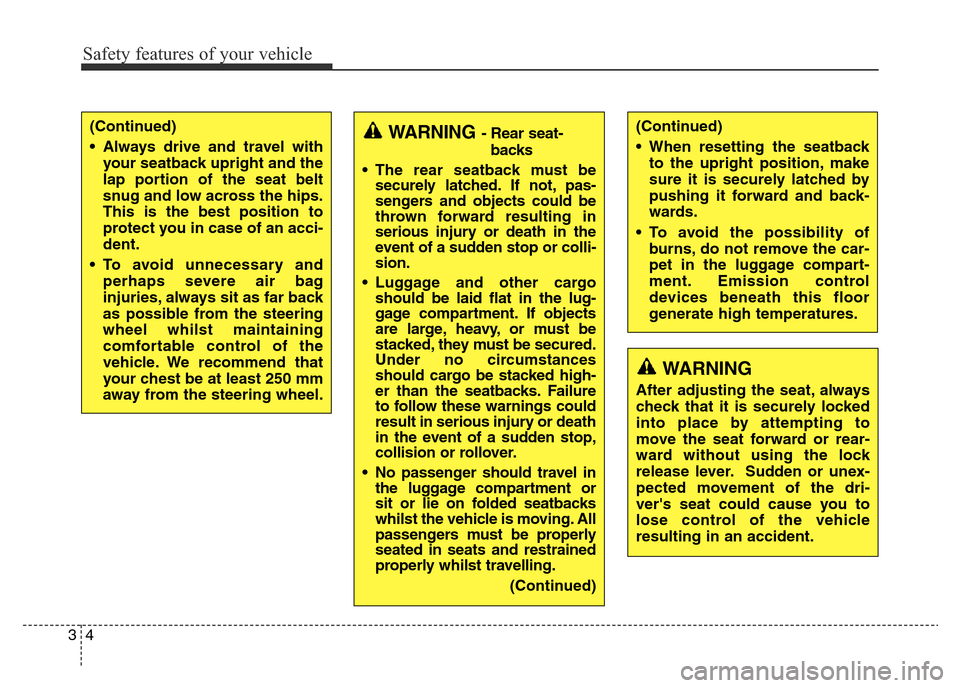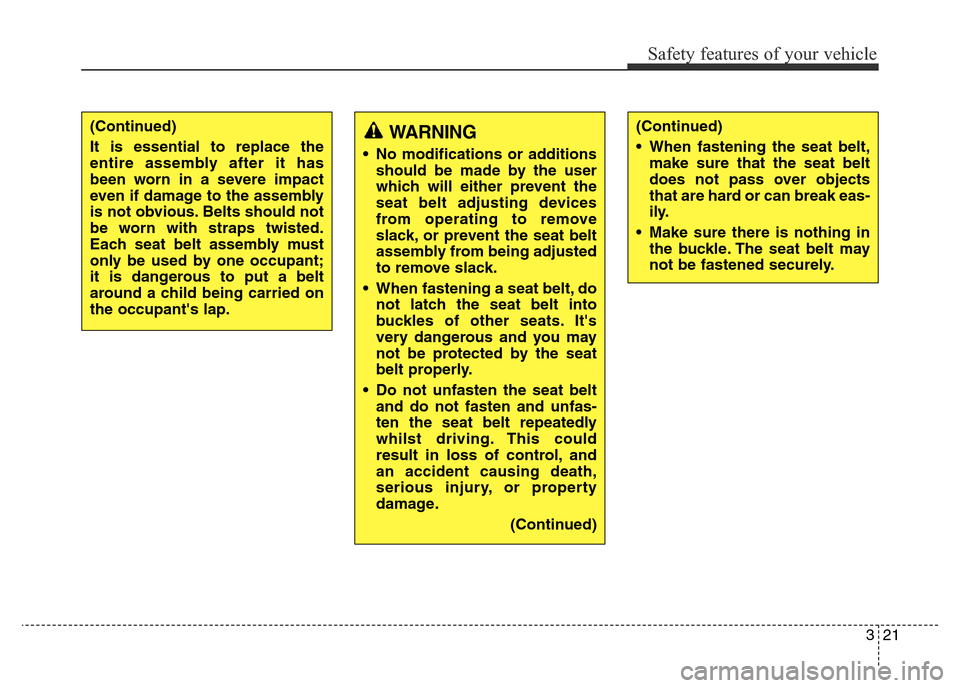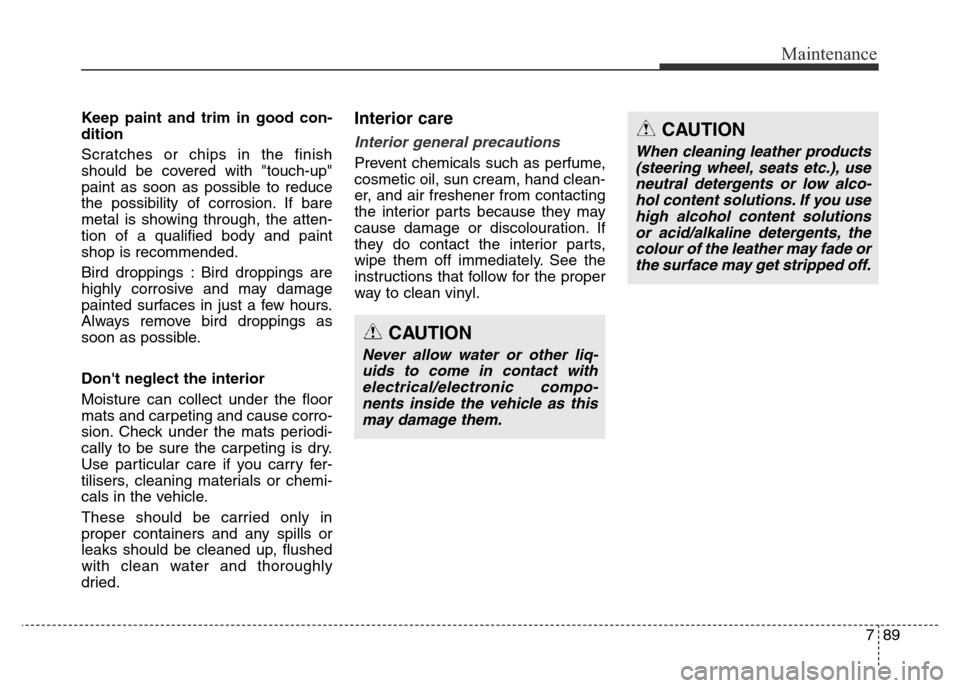2015 Hyundai Elantra remove seats
[x] Cancel search: remove seatsPage 22 of 498

Safety features of your vehicle
4 3
(Continued)
• Always drive and travel with
your seatback upright and the
lap portion of the seat belt
snug and low across the hips.
This is the best position to
protect you in case of an acci-
dent.
• To avoid unnecessary and
perhaps severe air bag
injuries, always sit as far back
as possible from the steering
wheel whilst maintaining
comfortable control of the
vehicle. We recommend that
your chest be at least 250 mm
away from the steering wheel.WARNING- Rear seat-
backs
• The rear seatback must be
securely latched. If not, pas-
sengers and objects could be
thrown forward resulting in
serious injury or death in the
event of a sudden stop or colli-
sion.
• Luggage and other cargo
should be laid flat in the lug-
gage compartment. If objects
are large, heavy, or must be
stacked, they must be secured.
Under no circumstances
should cargo be stacked high-
er than the seatbacks. Failure
to follow these warnings could
result in serious injury or death
in the event of a sudden stop,
collision or rollover.
• No passenger should travel in
the luggage compartment or
sit or lie on folded seatbacks
whilst the vehicle is moving. All
passengers must be properly
seated in seats and restrained
properly whilst travelling.
(Continued)(Continued)
• When resetting the seatback
to the upright position, make
sure it is securely latched by
pushing it forward and back-
wards.
• To avoid the possibility of
burns, do not remove the car-
pet in the luggage compart-
ment. Emission control
devices beneath this floor
generate high temperatures.
WARNING
After adjusting the seat, always
check that it is securely locked
into place by attempting to
move the seat forward or rear-
ward without using the lock
release lever. Sudden or unex-
pected movement of the dri-
ver's seat could cause you to
lose control of the vehicle
resulting in an accident.
Page 26 of 498

Safety features of your vehicle
8 3
Lumbar support (if equipped)
The lumbar support can be adjusted
by pressing the lumbar support
switch on the side of the driver's
seat. Press the front portion of the
switch to increase support, or the
rear portion of the switch, to
decrease support.
Headrest
The driver's and front passenger's
seats are equipped with a headrest
for the occupant's safety and com-
for t.
The headrest not only provides com-
fort for the driver and front passen-
ger, but also helps to protect the
head and neck in the event of a colli-
sion.
OMD030009/HOMG038400
WARNING
• For maximum effectiveness in
case of an accident, the head-
rest should be adjusted so the
middle of the headrest is at the
same height of the centre of
gravity of an occupant's head.
Generally, the centre of gravity
of most people's head is simi-
lar to the height of the top of
their eyes. Also, adjust the
headrest as close to your head
as possible. For this reason,
the use of a cushion that holds
the body away from the seat-
back is not recommended.
• Do not operate the vehicle
with the headrests removed as
severe injury to the occupants
may occur in the event of an
accident. Headrests may pro-
vide protection against neck
injuries when properly adjust-
ed.
• Do not adjust the headrest
position of the driver's seat
whilst the vehicle is in motion.
Page 31 of 498

313
Safety features of your vehicle
Seatback pocket (if equipped)Rear seat
Headrest
The rear seats are equipped with
headrests in all the seating positions
for the occupant's safety and com-
for t.
The headrest not only provides com-
fort for passengers, but also helps to
protect the head and neck in the
event of a collision.WARNING- Seatback
pockets
Do not put heavy or sharp
objects in the seatback pockets.
In an accident they could come
loose from the pocket and
injure vehicle occupants.
OMD030013
ONF039401
WARNING
• For maximum effectiveness in
case of an accident, the head-
rest should be adjusted so the
middle of the headrest is at
the same height of the centre
of gravity of an occupant's
head. Generally, the centre of
gravity of most people's head
is similar with the height of
the top of their eyes. Also
adjust the headrest as close
to your head as possible. For
this reason, the use of a cush-
ion that holds the body away
from the seatback is not rec-
ommended.
• Do not operate the vehicle
with the headrests removed
as severe injury to an occu-
pant may occur in the event of
an accident. Headrests may
provide protection against
severe neck injuries when
properly adjusted.
(Continued)
Page 32 of 498

Safety features of your vehicle
14 3
Adjusting the height up and down
To raise the headrest, pull it up (1).
To lower the headrest, push and hold
the release button (2) on the head-
rest support and lower the headrest
(3).Removal
To remove the headrest, raise it as far
as it can go then press the release
button (1) whilst pulling upward (2).
To reinstall the headrest, put the
headrest poles (3) into the holes
whilst pressing the release button
(1). Then adjust it to the appropriate
height.
(Continued)
• When there is no occupant in
the rear seats, adjust the
height of the headrest to the
lowest position. The rear seat
headrest can reduce the visi-
bility of the rear area.
OMD030016
WARNING
Make sure the headrest locks in
position after adjusting it to
properly protect the occupants.
OMD030015
Page 39 of 498

321
Safety features of your vehicle
WARNING
• No modifications or additions
should be made by the user
which will either prevent the
seat belt adjusting devices
from operating to remove
slack, or prevent the seat belt
assembly from being adjusted
to remove slack.
• When fastening a seat belt, do
not latch the seat belt into
buckles of other seats. It's
very dangerous and you may
not be protected by the seat
belt properly.
• Do not unfasten the seat belt
and do not fasten and unfas-
ten the seat belt repeatedly
whilst driving. This could
result in loss of control, and
an accident causing death,
serious injury, or property
damage.
(Continued)
(Continued)
• When fastening the seat belt,
make sure that the seat belt
does not pass over objects
that are hard or can break eas-
ily.
• Make sure there is nothing in
the buckle. The seat belt may
not be fastened securely.(Continued)
It is essential to replace the
entire assembly after it has
been worn in a severe impact
even if damage to the assembly
is not obvious. Belts should not
be worn with straps twisted.
Each seat belt assembly must
only be used by one occupant;
it is dangerous to put a belt
around a child being carried on
the occupant's lap.
Page 53 of 498

335
Safety features of your vehicle
Using a child restraint system
For small children and babies, the
use of a child seat or infant seat is
required. This child seat or infant
seat should be of appropriate size for
the child and should be installed in
accordance with the manufacturer's
instructions.
For safety reasons, we recommend
that the child restraint system is used
in the rear seats.
WARNING- Child seat
installation
• A child can be seriously
injured or killed in a collision
if the child restraint is not
properly anchored to the vehi-
cle and the child is not prop-
erly restrained in the child
restraint. Before installing the
child restraint system, read
the instructions supplied by
the child restraint system
manufacturer.
(Continued)
WARNING
Never place a rear-facing child
restraint in the front passenger
seat, because of the danger that
an inflating passenger-side air
bag could impact the rear-fac-
ing child restraint and kill the
child.
OCM019300
Rearward-facing child
restraint systemForward-facing child
restraint system
(Continued)
• If the seat belt does not oper-
ate as described in this sec-
tion, we recommend that the
system be checked by an
authorised HYUNDAI dealer.
• Failure to observe this manu-
al's instructions regarding
the child restraint system and
the instructions provided with
the child restraint system
could increase the risk and/or
severity of injury in an acci-
dent.
• If the vehicle headrest pre-
vents proper installation of a
child seat (as described in the
child seat system manual), the
headrest of the respective
seating position shall be read-
justed or entirely removed.
Page 484 of 498

789
Maintenance
Keep paint and trim in good con-
dition
Scratches or chips in the finish
should be covered with "touch-up"
paint as soon as possible to reduce
the possibility of corrosion. If bare
metal is showing through, the atten-
tion of a qualified body and paint
shop is recommended.
Bird droppings : Bird droppings are
highly corrosive and may damage
painted surfaces in just a few hours.
Always remove bird droppings as
soon as possible.
Don't neglect the interior
Moisture can collect under the floor
mats and carpeting and cause corro-
sion. Check under the mats periodi-
cally to be sure the carpeting is dry.
Use particular care if you carry fer-
tilisers, cleaning materials or chemi-
cals in the vehicle.
These should be carried only in
proper containers and any spills or
leaks should be cleaned up, flushed
with clean water and thoroughly
dried.Interior care
Interior general precautions
Prevent chemicals such as perfume,
cosmetic oil, sun cream, hand clean-
er, and air freshener from contacting
the interior parts because they may
cause damage or discolouration. If
they do contact the interior parts,
wipe them off immediately. See the
instructions that follow for the proper
way to clean vinyl.
CAUTION
Never allow water or other liq-
uids to come in contact with
electrical/electronic compo-
nents inside the vehicle as this
may damage them.
CAUTION
When cleaning leather products
(steering wheel, seats etc.), use
neutral detergents or low alco-
hol content solutions. If you use
high alcohol content solutions
or acid/alkaline detergents, the
colour of the leather may fade or
the surface may get stripped off.